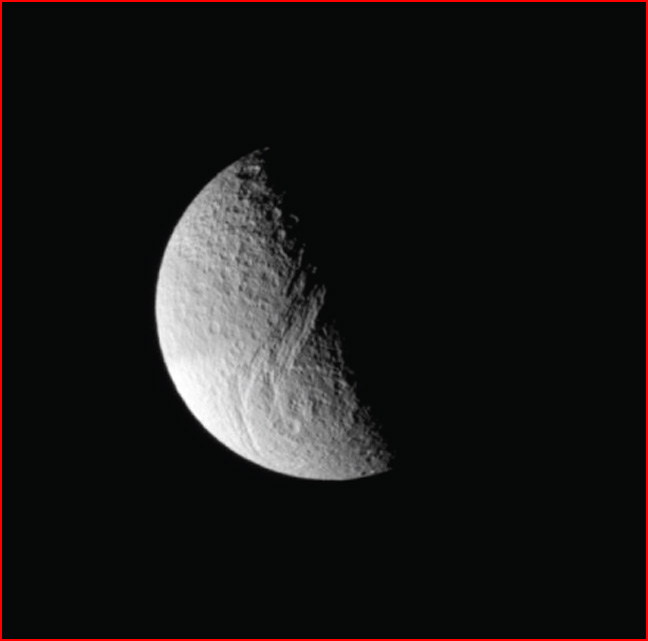
home •
about •
essential guide •
picture of the day •
thunderblogs •
news •
multimedia •
predictions •
products •
get involved •
contact
picture of the day archive subject index
Ithaca Chasma, Tethys. Credit: NASA/JPL Cassini-Huygens MissionDec 05, 2007
Tumultuous Tethys
Tethys has seen cataclysmic events in the past that have left it scarred and fractured. Could electric arcs have caused the damage?In the ongoing investigation of the Cassini orbiter's discoveries, the moon Tethys well represents our hypothesis that the Saturnian system (and the solar system in general) has experienced colossal plasma discharges in the past. Wherever we look there are the signs of electric discharge machining, cathode sputtering, anode blisters and sinuous channels deeply entrenched into the various bodies.
Tethys is 1071 kilometers in diameter, yet its surface features are disproportionately large in comparison to its size. Saturn's other moons exhibit the same difficulties with scale – moons of relatively small mass with craters and canyons that are hundreds of kilometers wide. Two such features on Tethys are Ithaca Chasma and the Odysseus Multi-Ring Formation. Odysseus Crater is 450 kilometers wide, with steep walls defining its outer boundary. The interior of the crater is flat with broad terraces marked by a prominent circular mountain range in the center. The "crown of Odysseus" rises to more than five kilometers in height and is 140 kilometers in diameter.
According to NASA scientists, the complex structure of this remarkable basin is due to the "rebound" of material after an asteroid hit the moon. The intense shockwaves passed through Tethys and reflected back off its far side, raising the central mound and forming the many rings that give the crater its name. Odysseus resembles the Asgard Multi-Ring Structure found on Jupiter's moon Callisto. On closer inspection, however, Odysseus appears to be spiral-shaped and not a concentricity.
Ithaca Chasma is a canyon over 1000 kilometers long and approximately 100 kilometers wide in some places. The enormous fissure is cut two kilometers deep into the surface of this ruined moon. How Tethys escaped being obliterated by the force of an impact sufficient to excavate these two structures is a mystery to conventional science.
In previous Thunderbolts Picture of the Day articles, we have considered the question of giant impacts into small celestial bodies and have concluded that the cause might not have been the impact of a big rock, but the touchdown of electric discharges. Mechanical shock, fluid dynamics and other Newtonian forces are not capable of selectively blasting objects and not destroying them in the process. In other words, how can the collision of forces transmit energies so powerful that they crack Tethys like an egg, but leave it intact?
Around the equator is a dark band of surface material that is lower than the mean elevation of the terrain surrounding it. Mission specialists believe it is a region of larger granules or ice crystals giving the surface a less reflective aspect. The dark band is more readily seen in the infrared spectrum.
Many of Saturn's moons seem to be partially covered with black "soot". Iapetus, Dione and Hyperion are all dusted with the same dark substance. In past commentary about those moons we have theorized that they were darkened by particles from Phoebe, the blackest object in the solar system. The plasmasphere of Saturn electrifies its environment and instigates plasma discharges on its family of moons. Enceladus, Dione and Tethys are all electrically active, flinging vast quantities of charged particles into space. Each moon is connected to its parent and to one another through cosmic electrical circuits. Tethys proves to be another example of electricity in space.
By Stephen Smith
___________________________________________________________________________Please visit our Forum
The Electric Sky and The Electric Universe available now!

|
|

|
EXECUTIVE EDITORS:
David Talbott, Wallace Thornhill
MANAGING EDITORS:
Steve Smith, Mel Acheson
CONTRIBUTING EDITORS: Michael Armstrong, Dwardu Cardona,
Ev Cochrane,
C.J. Ransom, Don Scott, Rens van der Sluijs, Ian Tresman
WEBMASTER: Brian Talbott
Copyright 2007: thunderbolts.info
![]()
home •
thunderblogs •
forum •
picture of the day •
resources •
team •
updates •
contact us

